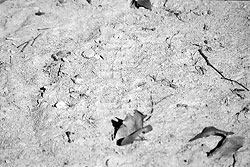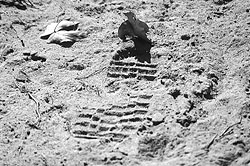 |
 |
| Sun position can play an important role in tracking. In photo (a) the sun is behind the tracker, whilst in (b) it is in front. At midday tracking is at its most difficult, since you cannot use shadow to highlight spoor. |
To give an example of what I am talking about, let me narrate what happened to me at Hwange Main Camp when I was stationed there. Being a large camp and the hub of administration for the huge park, there was a large staff of up to a thousand souls. In those days, the early seventies, we were allowed to take animals for rations and buffalo was the natural choice. Apart from being numerous, it was an acceptable meat to most of the staff whose family totems came into play when meat was involved. I am sure that the Nyati’s (Ndebele name meaning buffalo) on the staff, crossed their fingers behind their back or whatever and tucked in with the rest. So we, Senior Ranger William Koen and myself, went out at the end of every month and shot eight buffalo for rations. It was during our war years, so when we were called up for a stint in the Army, others were tasked with the job. When we arrived back on station a month later, we were greeted with cries of acclaim and Japan, the head tracker said, “Now we can eat”. He had taken out a couple of young rangers to carry out the monthly ration hunt. However, when they found the buffalo, battle commenced with bullets winging their way in all directions and a lone cow was the end result. For the next week, Japan took these rangers out on buffalo spoor, fresh and steaming in the winter mornings, but nary a buffalo did they get as the cunning old fox switched tracks time and again. He wasn’t going to get himself shot for any amount of meat. To this day, I don’t know if those rangers are aware of the merry dance they were led. By ten o’clock the next morning, we had tracked and shot our monthly quota. Not that we did the tracking that day but it serves to illustrate what I am talking about.
Some people have a natural aptitude and others say that really good trackers are born and not made. That may be so but with a few pointers and plenty of practice anyone can become reasonably proficient.
Now you obviously won’t be able to head over to your nearest open space and be able to pick up tracks of game. Start tracking by using your eyes. Sounds trite but most of us are sloppy about looking - really looking at things. Get used to looking about ten metres ahead when you are walking, flick your focus ahead and closer to you as you go. What is that on the pavement ahead? A chewing gum wrapper, a cigarette end, ah ha-a 10c coin lying on the sidewalk with the non-tracker walking straight over it. Already you have made it work.
Get somebody to walk ahead of you in the bush and follow his tracks, if you are taking the dog for a walk, try and pick up his tracks as you go. A tip is to imagine lifting the terrain up towards you - focus. Also don’t forget to look ahead as well. Animals walking normally won’t try and force their way through a thick bush or over a rock, they will go around it. You can get a feel for the general direction the quarry has taken if you study the terrain ahead.
In grassy areas, you may not have footprints to go on, and here you use aerial tracking - grass stems bent over in one direction to form a line, a twig or leaves broken off a bush, fresh mud on the trunk of a tree or if a wounded animal, traces of blood on leaves and bark.
The signs of an animal’s passing will be there, it is just a case of recognizing the clues left behind. Pebbles moved out of their position, a shiny surface replaced by the dull underside which has lain in the ground, a stick disturbed with the same result, muddy side uppermost. Leaves also have a bright and dull side, larger leaves can be crushed and not moved.
|